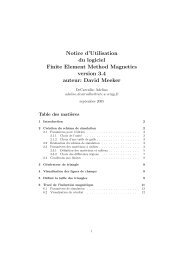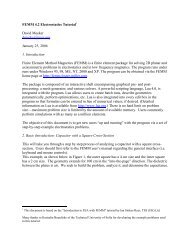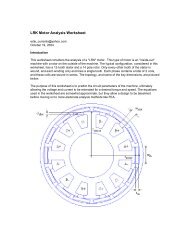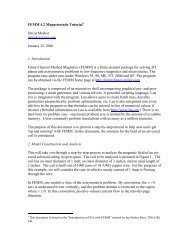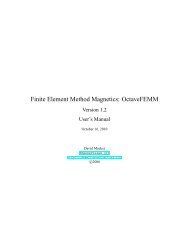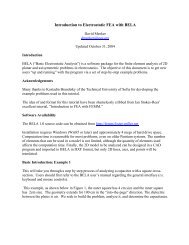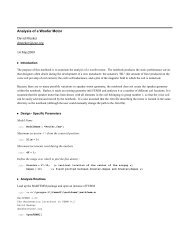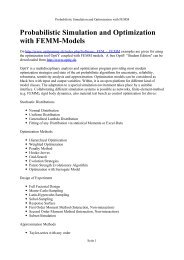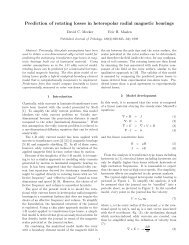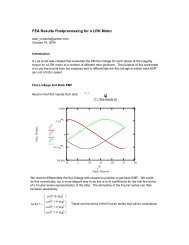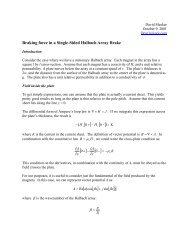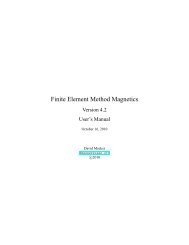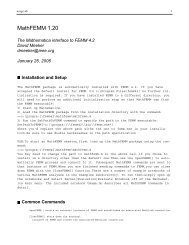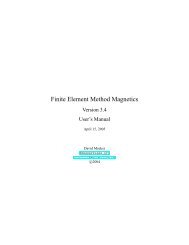FEMM Manual - Finite Element Method Magnetics
FEMM Manual - Finite Element Method Magnetics
FEMM Manual - Finite Element Method Magnetics
Create successful ePaper yourself
Turn your PDF publications into a flip-book with our unique Google optimized e-Paper software.
• Rˆ2 (i.e. Moment of Inertia/density) This integral is used to determine the moment<br />
of inertial of the selected blocks. To obtain moment of inertia, the result of this integral must<br />
be multiplied by the density of the selected region. For 2D planar problems, the moment of<br />
inertia about the z-axis (i.e. about x=0,y=0) is computed. For axisymmetric problems, the<br />
integral is computed about the r=0 axis.<br />
2.3.12 Force/Torque Calculation<br />
Ultimately, the estimation of magnetically produced forces and torques is often the goal of a finite<br />
element analysis. This section discusses some of the different methods of deducing forces and<br />
torques using <strong>FEMM</strong>.<br />
Lorentz Force/Torque<br />
If one is attempting to compute the force on a collection of currents in a region containing only<br />
materials with a unit relative permeability, the volume integral of Lorentz torque is always the<br />
method to employ. Lorentz force results tend to be very accurate. However, again, they are only<br />
applicable for the forces on conductors of with unit permeability (e.g. coils in a voice coil actuator).<br />
Weighted Stress Tensor Volume Integral<br />
This volume integral greatly simplifies the computation of forces and torques, as compared to<br />
evaluating forces via the stress tensor line integral of differentiation of coenergy. Merely select the<br />
blocks upon which force or torque are to be computed and evaluate the integral. No particular “art”<br />
is required in getting good force or torque results (as opposed to the Stress tensor line integral),<br />
although results tend to be more accurate with finer meshing around the region upon which the<br />
force or torque is to be computed.<br />
One limitation of the Weighted Stress Tensor integral is that the regions upon which the force is<br />
being computed must be entirely surrounded by air and/or abutting a boundary. In cases in which<br />
the desired region abuts a non-air region, force results may be deduced from differentiation of<br />
coenergy–see (2.14).<br />
Maxwell Stress Tensor Line Integral<br />
The indiscriminate use Maxwell’s Stress Tensor can result in bad predictions forces and torques.<br />
The goal of this section is to explain how to set up problems and properly choose integration<br />
paths so that good estimations of force and torque might be obtained via stress tensor methods.<br />
Generally, you should not use the Stress Tensor line integral to compute forces and torques if it can<br />
be avoided (i.e. use the volume integral version instead).<br />
Maxwell’s stress tensor prescribes a force per unit area produced by the magnetic field on a<br />
surface. The differential force produced is:<br />
dF = 1 2 (H(B · n)+B(H · n) −(H · B)n) (2.16)<br />
where n denotes the direction normal to the surface at the point of interest. The net force on an<br />
object is obtained by creating a surface totally enclosing the object of interest and integrating the<br />
magnetic stress over that surface.<br />
44



